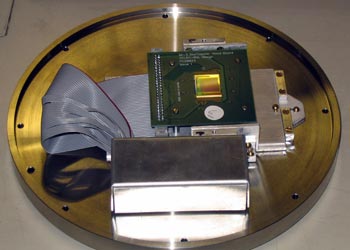|
A second type of direct detector we have evaluated is a Monolithic Active Pixel Sensor (MAPS), designed in CMOS technology. Unlike the hybrid pixel detector, it is entirely contained in a single layer of silicon, which can be thinned down to be only a few tens of microns. The thinness of the detector should theoretically allow us to obtain even better resolution than the hybrid detectors, particularly at higher electron energie.

Publications related to MAPS work
-
Direct Single Electron detection with a CMOS Detector for Electron Microscopy
A.R.Faruqi, R.Henderson, M.Prydderch, R.Turchetta, P.Allport and A.Evans
Nucl. Instr. and Meth., 546, 170-175, (2005).
- CMOS active pixel sensors for ionising radiation
D.A. Evans, P.P. Allport, G. Casse, A.R. Faruqi, B. Gallop, R. Henderson, M. Prydderch, R. Turchetta, M. Tyndel, J. Velthuis, G.Villani, N. Waltham
Nucl. Instr. and Meth., 546 ,281-285, (2005).
- CMOS Monolithic Active Pixel Sensors (MAPS): New ‘eyes’ for science
R. Turchetta, P.P. Allport, G. Casse, A. Clark, J. Crooks, A. Evans, A. Fant, A.R. Faruqi, M.J. French, R. Henderson, Q. Morrissey, D. Prior, M. Prydderch, J.J. Velthuis, G. Villani, N. Waltham, B. Willmore, P. Willmore
Nucl. Instr. and Meth., 560, (2005),139-142.
- Radiation Damage Studies on STAR250 CMOS Sensor at 300 keV for Electron Microscopy
A.R.Faruqi, R.Henderson, J.Holmes
Nucl. Instr. and Meth., A565, (2006), 139-143.
- Experimental observation of the improvement in MTF from backthinning a CMOS direct electron detector
G. McMullan, A. R. Faruqi, R. Henderson, N. Guerrini, R. Turchetta, A. Jacobs and G. van Hoften
EMC 2008 14th European Microscopy Congress 1-5 September 2008, Aachen, Germany, 1 (2008),73-74.
- The Detective Quantum Efficiency of Electron Area Detectors in Electron Microscopy
G.McMullan, R.Henderson, S.Chen and A.R.Faruqi
Ultramicroscopy, 109 (2009) 1126-1143.
- Experimental observation of the improvement in MTF from backthinning a CMOS direct electron detector
G. McMullan, A. R. Faruqi, R. Henderson, N. Guerrini, R.Turchetta, A.Jacobs, G.van Hoften
Ultramicroscopy, 109 (2009) 1144–1147.
- Enhanced imaging in lowdose electron microscopy using electron counting
G. McMullan, A.T.Clark, R.Turchetta, A.R.Faruqi
Ultramicroscopy, 109 (2009), 1411-1416.
- A high frame rate, 16 Million pixels, radiation hard CMOS sensor
N. Guerrini, R. Turchetta, G. Van Hoften , R. Henderson, G. McMullan, A. R. Faruqi
J. Inst. (2011), (http://dx.doi.org/10.1088/1748-0221/6/03/C03003).
- Single event imaging for electron microscopy using MAPS detectors
McMullan, G., Turchetta, R. & Faruqi, A. R
JINST, 6 (2011), C04001.
- Comparison of optimal performance at 300keV of three direct electron detectors for use in low dose electron microscopy.
McMullan, G., Faruqi, A. R., Clare, D. & Henderson, R.
Ultramicroscopy, 147, (2014), 156-163.
|